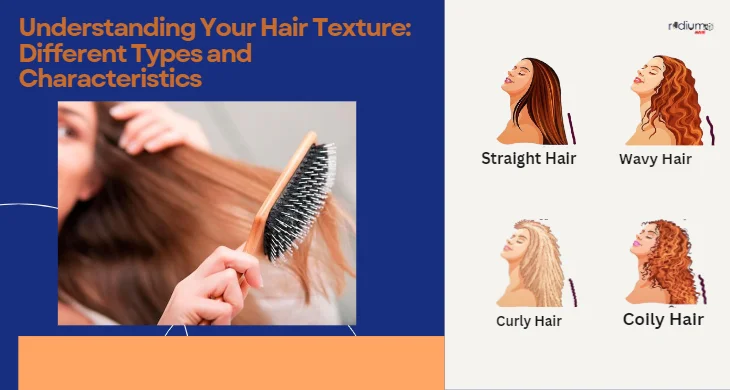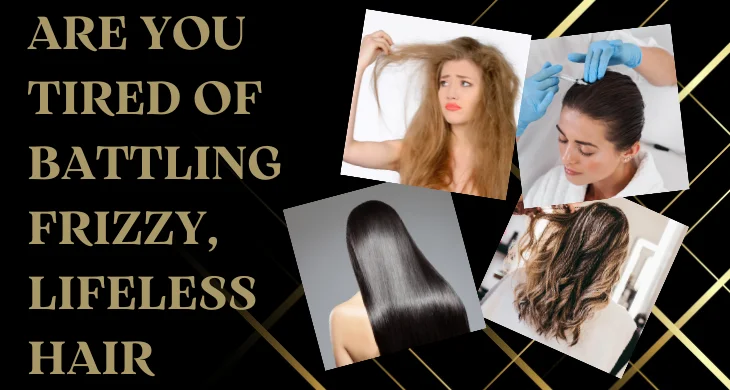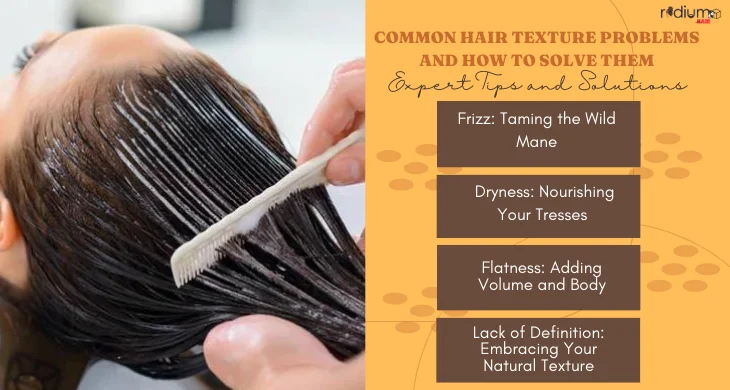Have you ever wondered why some people have curly hair while others have straight hair? Or why
certain hairstyles look stunning on some individuals but not on others? The answer lies in the unique
hair texture that each person possesses. Understanding your hair texture is crucial for making
informed decisions about hair care, styling & product selection. In this comprehensive guide, we will
delve into the world of hair texture, exploring its different types and characteristics. So, grab a cup of
coffee and let’s embark on this hair-raising journey!
What is Hair Texture?
Before we dive into the various types of hair texture, let’s establish a clear understanding of what hair
texture actually means. Hair texture refers to the thickness, diameter, and overall structure of
individual hair strands. It determines how the hair feels, looks and behaves. Hair texture is primarily
determined by genetics, although external factors such as climate, styling practices and chemical
treatments can also influence it.
Understanding Your Hair Texture: Different Types and Characteristic
To better understand the diverse world of hair texture,let’s explore the different types and
characteristics:
1. Straight Hair
Straight hair is characterized by its sleek, smooth, and glossy appearance. It lacks noticeable waves,
curls, or kinks. Straight hair tends to be shinier than other hair types due to its ability to reflect light
evenly along the hair shaft. It is often perceived as being silky and is less prone to frizz.
2. Wavy Hair
Wavy hair falls somewhere between straight and curly hair. It has a gentle S-shaped pattern that adds
volume and movement to the hair. Wavy hair can vary in texture, with some individuals having loose
waves, while others have more defined & structured waves. This hair type is versatile and can be
styled in various ways.
3. Curly Hair
Curly hair is characterized by its spiral or coiled shape. It ranges from loose curls to tight corkscrews.
Curly hair tends to be more prone to frizz due to its structure, which makes it harder for natural oils to
travel down the hair shaft. This hair type often requires specific care and styling techniques to
enhance its natural beauty.
4. Coily Hair
Coily hair, also known as kinky or afro textured hair, has tight curls or coils. It has the most fragile and
delicate structure among all hair types, requiring extra care to maintain moisture and prevent
breakage. Coily hair has a unique beauty and can be styled in various ways, including afros, twists,
braids and locs.
5. Fine Hair
Fine hair refers to the thickness of individual hair strands. It is characterized by its small diameter and
can often appear thin or wispy. Fine hair is prone to oiliness and can become weighed down easily by
heavy hair products. However, it tends to be more manageable and can hold styles well due to its
lightweight nature.
6. Medium Hair
Medium hair falls between fine and coarse hair in terms of thickness. It is neither too thin nor too
thick, striking a balance between manageability and versatility. Medium hair can generally hold styles
well and requires less maintenance compared to fine or coarse hair.
7. Coarse Hair
Coarse hair is the thickest hair type, characterized by its large diameter. It often feels rougher to the
touch and appears more voluminous. Coarse hair can withstand heat styling and chemical treatments
better than fine hair, but it requires regular deep conditioning and moisturization to prevent dryness
and frizz.
8. Density (continued)
Hair density can vary greatly among individuals. Some people have thick, dense hair with a high
number of strands per square inch, creating a full and voluminous appearance. On the other hand,
some individuals have thin or low-density hair , which may appear sparse or lack volume.
Understanding your hair density is essential for choosing appropriate hairstyles and products that can
enhance the overall look and feel of your hair.
9. Porosity
Hair porosity refers to the hair’s ability to absorb and retain moisture. It is determined by the hair’s
cuticle structure, which can be tightly closed (low porosity), moderately open (medium porosity), or
highly porous with gaps and holes (high porosity). Understanding your hair’s porosity can help you
establish a suitable hair care routine and choose products that effectively moisturize and nourish your
hair
10. Elasticity
Hair elasticity refers to its ability to stretch and return to its original shape without breaking. It is a
vital characteristic that determines how well the hair can withstand styling practices and resist
damage. Hair with good elasticity can withstand heat styling & chemical treatments without severe
breakage. On the other hand, low elasticity can make the hair more susceptible to breakage and
damage.
11. Color and Texture Diversity
Hair texture and characteristics not only vary in terms of straightness, waviness, or curliness but also
in terms of color and texture diversity. People with the same hair type can have different textures,
ranging from silky smooth to coarse and wiry. Additionally, the color of the hair adds another layer of
uniqueness, with a wide range of natural hues, highlights and undertones. Embracing and appreciating
the diversity of hair texture, color and patterns is a beautiful celebration of individuality.
Frequently Asked Questions (FAQs)

Now, let’s address some common questions about hair texture:
Ques. What factors determine my hair texture?
Ans. Hair texture is primarily determined by genetics. The genes inherited from your parents influence the
shape, thickness and overall characteristics of your hair strands. However, environmental factors, such
as climate, humidity and styling practices, can also affect the appearance and behavior of your hair.
Ques. Can my hair texture change over time?
Ans. While your genetic makeup largely determines your hair texture, certain factors can temporarily alter
its appearance. Hormonal changes, age, pregnancy and medical conditions can all impact the texture
of your hair. Additionally, chemical treatments like perming or relaxing can permanently change the
structure of your hair strands.
Ques. How can I determine my hair porosity?
Ans. You can perform a simple test to determine your hair porosity. Take a clean strand of hair and place it
in a glass of water. If it floats on the surface, your hair has low porosity. If it sinks slowly, your hair has
medium porosity. And if it sinks immediately, your hair has high porosity.
Ques. What hairstyles are best suited for different hair textures?
Ans. Different hairstyles complement different hair textures. For straight hair, sleek and smooth styles work
well. Wavy hair can be enhanced with beachy waves or loose curls. Curly and coily hair can be styled in
various ways, including twists, braids and updos. Experiment with different styles to find what suits
your unique hair texture and personal style.
Ques. How can I care for my specific hair texture?
Ans. Caring for your specific hair texture involves using appropriate hair care products and techniques. For
example, individuals with curly or coily hair benefit from deep conditioning, moisturizing products,
and gentle detangling methods. Fine hair may require lightweight products and volumizing
techniques. Understanding your hair texture will guide you in choosing the right products and
implementing a suitable hair care routine.
Ques. Can I change my hair texture permanently?
Ans. While there are temporary styling methods that can alter the appearance of your hair texture, there is
currently no scientifically proven method to permanently change your natural hair texture. Chemical
treatments like relaxers or perms can offer temporary changes, but these processes can also damage
the hair if not done correctly or maintained properly.
Conclusion
Understanding your hair texture is essential for maintaining healthy, beautiful hair. By identifying your
hair type, density, porosity and other characteristics, you can make informed decisions about hair care
routines, styling methods, and product selection. Embrace the uniqueness of your hair and
experiment with different styles and techniques that enhance your natural beauty. Remember,
everyone’s hair is different and what works for someone else may not work for you. Embrace your hair
texture, celebrate its diversity, and enjoy the journey of discovering the best ways to care for and style
your locks!



